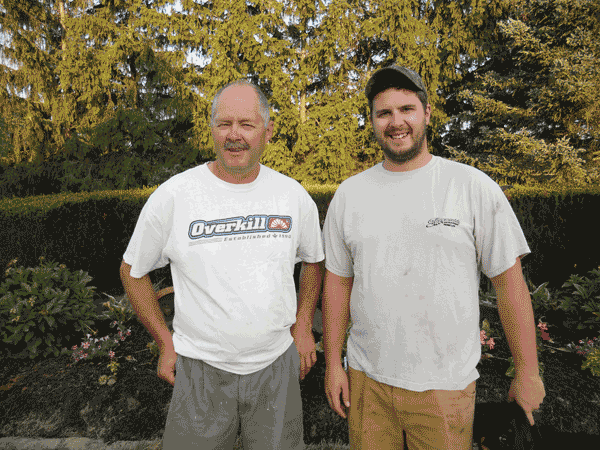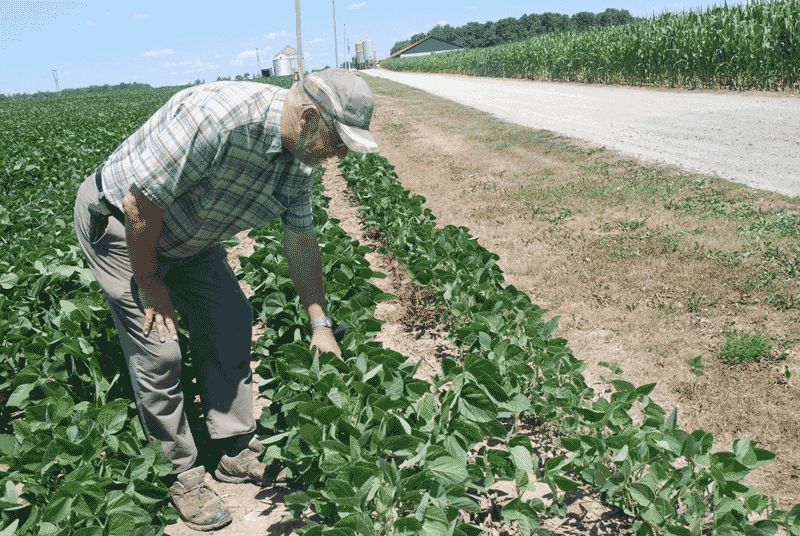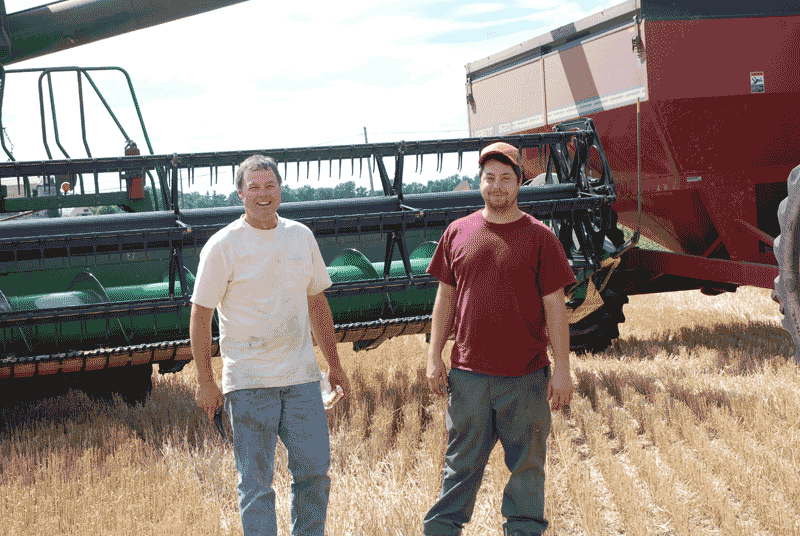Changing landscape
PREPARING FOR HARVEST AND THE FUTURE OF FARMING
the farming landscape is changing in Ontario. According to the 2011 Census of Agriculture, a summary of which was released this summer, there has been a decrease in both the number of farms in the province and the number of farm operators since the last census was taken in 2006. This continues the steady decline that’s been seen since 1941. The statistics also show a trend towards consolidation – with the number of small farms decreasing, and the number of large farms increasing.
More than 70 percent of Ontario’s farm area is cropland, which makes the statistics a reality for many grain farmers struggling to deal with a changing industry and the loss of farmland to urban sprawl.
typical farm operation
As Hank Bakker thinks about the upcoming harvest, he’s optimistic about this year’s soybean crop. Despite challenges created by hot temperatures and a lack of rain mid-season, “I’m proud of my soybeans,” he boasts as he examines a few plants in the field. “Don’t look at the corn though; it’s struggling with this weather.”
Hank owns a mixed operation known as Dirk Bakker Farms Ltd; he’s a pig farmer who also grows corn and soybeans in Norfolk County. According to Statistics Canada, he’s what you’d consider to be the typical farmer in Ontario. The census revealed the average area per farm was 244 acres, up slightly from 233 acres five years ago. Hank owns 240 acres, and rents an additional 210 acres.
It’s a family operation – Hank’s son Brad, has already taken over the pigs and helps make some of the cropping decisions. This year, they have about 300 acres of corn that will be used for feed, and more than 100 acres of soybeans that they’ll sell. Planning what to keep for use on their farm, and what to sell, is one of the decisions they have to make during their preparations for harvest.
“If Mother Nature cooperates we won’t have enough capacity to store all the corn we need for feed here on the farm as well as the soybeans,” explains Hank. “But we like to keep a bin full of soybeans so we can take advantage of market prices through the winter.”
It’s an important means of balancing cash flow during the winter, but it’s a decision they have to start thinking about in the summer once they’ve made a few yield estimates. That can be tricky since they notice a significant difference between the manured land on their home farm and their rented fields which don’t receive that same fertilizer. This year, the average yield was even more difficult to assess given the drought conditions in their region mid-summer. Even though the rented fields are all within ten kilometres of the home farm, they still have different water tables and soil types which affect crop performance.
The summer is also when the Bakkers start making sure they have all of their equipment ready and in top shape. “We want to get through harvest without any major repairs,” says Hank.
This year, their equipment preparation included building wagons to transport their crops. Brad took on this project; buying a trailer with air brakes, and then building a hitch and box onto the frame. He’s also helping to get the grain dryer and combine ready. They just bought a new machine last year – an expense they could only justify after the old one caught fire.
Hiring extra labour is also an issue for the family. They have one hired hand, but they need additional help during harvest because they also have to keep the pig operation going at the same time. The Bakkers say it’s hard to find decent help at a price they can afford.
Seeing the trend towards larger farm operations, the family has considered expanding. “But finding acres that are economical is a challenge,” says Brad. “Sometimes there are acres to be had but they’re not viable for cash cropping.”
However, the future of their farm is a concern for Hank if they don’t expand. “What we have now is a viable farming operation, but given how much farming has changed in the last ten years it’s getting harder to compete with the economies of scale.”
large farm operation
Shermandale Farms Limited, owned by brothers Steve and Reg Smith, is one of those larger scale operations that fit the census description of an expanding agricultural business. They work five thousand acres (more than half of which is owned) across three counties – Brant, Norfolk, and Hamilton-Wentworth. This year, they’re preparing to harvest about two thousand acres each of corn and soybeans, and several hundred acres of wheat.
PHOTO 1: REG SMITH, 54, AND HIS SON TED, 25.

PHOTO 2: HANK BAKKER, 62, CHECKS ON HIS SOYBEANS.

PHOTO 3: STEVE SMITH, 51, AND HIS SON JERRY, 24.

Reg’s son, Ted, and Steve’s son, Jerry, are actively involved in running the operation throughout the year. And even though it’s one of their busiest times, it’s still just the family during the harvest season, with only the occasional outside help. But that too is usually extended family – a cousin or a nephew who can run one of the trucks if needed.
“The key is we all have our own area to work on, and we stay out of each other’s way,” says Steve. He does most of the combining, while Reg will drive the grain buggy and their sons drive the trucks back and forth from the elevator.
That’s the newest part of their operation; they just purchased a grain elevator in eastern Brant County at the beginning of July. “I’ve always wanted an elevator,” Reg beams. “It’s out of our expertise, but the business has good employees that know how it runs. So I’m cautiously excited about this new venture.”
It’s just one way that the family is continuing to expand their farming business. The Smiths are also continuing to increase their acreage; they purchased another 260 acres this spring.
“We’re bigger than I ever intended at this point,” notes Steve. “We’re comfortable with the amount of land we have now, but we will always take the opportunity to buy land when it comes along. There never seems to
be enough acres for everyone, that’s why buying the elevator puts us in a good position.”
With their operation widespread, and only one combine, the Smiths have to keep a close eye on the progress of each of their fields. Luckily, with varying soil and weather conditions, not all of their crops are ready to harvest at once. They can also move to a different field if they have to.
“Our harvest schedule is also based on how hard it is to get into the field,” says Reg. “We see some field conditions really deteriorate into the fall, so we try to get to them first.”
“With the heavy clay in Brant County, we can’t be out when the ground is wet,” adds Steve. “We have to wait for it to dry, even if it affects yields.”
Planning for harvest also involves preparing a lot of back-up plans. According to Steve, it doesn’t pay to worry about what’s going to happen, you just need to know how to handle it. They’ve had years where the motor has blown on the combine, trucks have been involved in accidents, and the tail end of a hurricane has ruined an entire corn crop.
“The biggest thing is not to be overwhelmed when I start thinking about how many acres there are to do,” says Steve. “When the weather is bad you start to worry and you have to try not to stress too much.”
That’s when those back-up plans come into play. “We have neighbours who come and help to get the soybeans done at the right time because they’re tougher to get off if the weather goes bad.”
Like the Bakkers, the Smiths also make sure their equipment is ready for harvest. The purchase of the grain elevator increased their fleet of trucks from two to six. They also have to do maintenance on the combine, and make sure the fall tillage equipment is ready to go right after the harvest. With the help of sons Ted and Jerry, it’s a process that takes about a month to complete.
uncertain future
When Reg compares Shermandale Farms to other operations, he still likes to consider himself the little guy – even though there are fewer than a hundred farms that cover more than 3,500 acres in the province. Large operations only represent about 11 percent of all farms in the province, but they accounted for 68 percent of total gross farm receipts in 2010.
Whether Ontario grain farmers are harvesting thousands of acres, or a few hundred, they have to deal with the same problems with equipment and the weather in order to get the job done. As the landscape of the province’s farms continues to change, the question is who will still be doing that job in the future. •






















